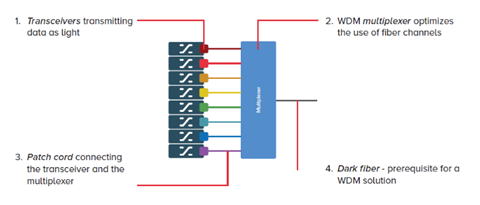We know that fiber can carry more data over long distances than any other physical medium. That makes fiber a very precious material. And how to make the most use of your fiber plant becomes a question. So there comes Wavelength Division Multiplexing (WDM).

Why Should We Deploy WDM ?
WDM can multiply your fiber capacity by creating virtual fibers. The foundation of WDM lies in the ability to send different data types over fiber networks in the form of light. By allowing different light channels, each with a unique wavelength, to be sent simultaneously over an optical fiber network, a single virtual fiber network is created. Instead of using multiple fibers for each and every service, a single fiber can be shared for several services. In this way WDM increases the bandwidth and maximizes the usefulness of fiber. Since fiber rental or purchase accounts for a large share of networking costs, substantial costs can be saved through the application of WDM. Next I will introduce to you the basic four elements in the form of a WDM system.
The Core Technology of WDM System
Generally speaking, a WDM system consists of four elements, that are transceiver, multiplexer, patch cord and dark fiber. The following text will explain them to you respectively.
- Fiber Optic Transceivers. Optical transceivers are wavelength-specific lasers that convert data signals from SAN or WAN to optical signals that can be transmitted into the fiber. Each data stream is converted into a signal with a light wavelength that is an unique color. Due to the physical properties of light, channels cannot interfere with each other. Therefore, all WDM wavelengths are independent. Creating virtual fiber channels in this way can reduce the number of fibers required. It also allows new channels to be connected as needed, without disrupting the existing traffic services.
- Optical Multiplexers. The WDM multiplexer, sometimes referred to as the Mux, is the key to optimizing, or maximizing, the use of the fiber. The multiplexer is at the heart of the operation, gathering all the data streams together to be transported simultaneously over a single fiber. At the other end of the fiber the streams are demultiplexed and separated into different channels again.
- Patch cord. The transceiver transmits the high-speed data protocols on narrow band wavelengths while the multiplexer is at the heart of the operation. The patch cable is the glue that joins these two key elements together. LC fiber patch cables are popular, which connect the output of the transceiver to the input on the multiplexer.
- Dark fiber. A requisite for any WDM solution is access to a dark fiber network. The most common way of transporting optical traffic over an architecture is by using a fiber pair. One of the fibers is used for transmitting the data and the other is used for receiving the data. This allows the maximum amount of traffic to be transported. At times only a single fiber is available. Because different light colors travel on different wavelengths, a WDM system can be built regardless. One wavelength is used to send data and a second one to receive it.
Conclusion
WDM has revolutionized the cost of network transport. Thanks to WDM, fiber networks can carry multiple Terabits of data per second over thousands of kilometers with a low cost that is unimaginable less than a decade ago. At FS, we offer a comprehensive portfolio of WDM transmission modules to support the network applications of enterprise and service provider customers. For more details, please visit www.fs.com.


Thank you for sharing the information.
ReplyDeletePassive Networking
Structured Cabling